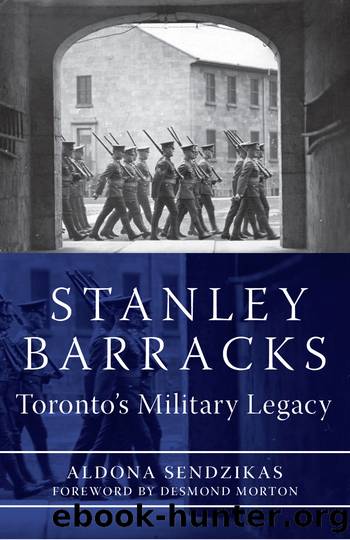Stanley Barracks by Aldona Sendzikas

Author:Aldona Sendzikas
Language: eng
Format: epub
ISBN: 9781459711693
Publisher: Dundurn Press
These posters, demanding the registration of âenemy aliens,â were posted in several languages throughout the city of Toronto in 1914. Creator unknown.
C 233-2-7-0-309, Archives of Ontario War Poster Collection.
As early as August 1914, the Military Council in Ottawa had begun looking for a suitable facility for the internment of reservists in Toronto. The site suggested by the GOC, Military District No. 2, was Stanley Barracks, both because of its convenience and security: âRecommend portion Stanley Barracks. Troops for guards always there, easy to superintend, supply, etc.â This choice of location was approved, and by September work had begun to convert Stanley Barracks into an internment station. The GOC reported on the progress: âRe internment Stanley Barracks. Possible to provide accommodation for eighty. Will take four weeks or more to complete arrangements. Electric wiring and fencing can be done in ten days, but bars will take some time, work will be hastened as fast as possible.â And there definitely was no time to waste. As early as September 7, a German reservist was being escorted from Orangeville to Toronto to be âconfined at Stanley Barracks.â19
Of course, not all of Stanley Barracks could be spared for internment. The building designated for internment was the cavalry quarters, or the âWest Blockâ â the privatesâ barracks on the west side of the fort, originally known as Range No. 2, which had a capacity of ninety men. A plan of Stanley Barracks, drafted by Lieutenant H.J. Burden in 1915, labels Range No. 2 as the âPrison Block.â The 1915 plan also indicates that a âPrisoners Yardâ had been laid out and enclosed in the southwest corner of the fort, between the officersâ quarters and the new hospital.20
During the war, Stanley Barracks functioned as a âReceiving Station,â rather than a full-fledged internment camp. Receiving stations served as transit centres for internees en route to more permanent quarters. This was most likely due to the limited capacity of the internment quarters at Stanley Barracks. Weekly reports issued regarding prisoners of war at Stanley Barracks show the number of internees fluctuating frequently, sometimes even weekly. A report issued in mid-October indicates that there were already seven prisoners at Stanley Barracks, three of them reservists. Two months later, the cavalry quarters were filled to capacity, and the general officer commanding of Military District No. 2 reported to Otter: âNinety-three prisoners of war in Stanley Barracks. No room for more.â21
The weekly reports that were issued list most of the internees at Stanley Barracks as âAustrianâ or âHungarian.â They were âcapturedâ in various places: some in Toronto, others in towns such as Thorold, Hamilton, Brampton, or Niagara Falls, before being taken to Toronto. The internees often would be transferred from Stanley Barracks to internment sites such as Fort Henry or the camp at Kapuskasing.22
Download
This site does not store any files on its server. We only index and link to content provided by other sites. Please contact the content providers to delete copyright contents if any and email us, we'll remove relevant links or contents immediately.
The Radium Girls by Kate Moore(11930)
100 Deadly Skills by Clint Emerson(4845)
Rise and Kill First by Ronen Bergman(4705)
The Templars by Dan Jones(4629)
The Doomsday Machine by Daniel Ellsberg(4420)
The Rape of Nanking by Iris Chang(4140)
Killing England by Bill O'Reilly(3953)
Hitler in Los Angeles by Steven J. Ross(3902)
Stalin by Stephen Kotkin(3883)
12 Strong by Doug Stanton(3511)
Hitler's Monsters by Eric Kurlander(3269)
Blood and Sand by Alex Von Tunzelmann(3140)
The Code Book by Simon Singh(3077)
Darkest Hour by Anthony McCarten(3072)
The Art of War Visualized by Jessica Hagy(2945)
Hitler's Flying Saucers: A Guide to German Flying Discs of the Second World War by Stevens Henry(2716)
Babylon's Ark by Lawrence Anthony(2622)
The Second World Wars by Victor Davis Hanson(2485)
Tobruk by Peter Fitzsimons(2447)
